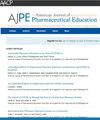The Case for Specifications Grading
IF 3.5
4区 教育学
Q1 EDUCATION, SCIENTIFIC DISCIPLINES
引用次数: 0
Abstract
Grades profoundly shape student approaches to learning, yet traditional points-based systems are often misaligned with educational goals. Specifications grading has emerged as a viable alternative that promotes mastery learning, transparency, and rigor. This grading approach replaces numerical points with clearly defined pass/fail criteria tied to course outcomes. Three essential components of specifications grading are precise specifications for competency, descriptive feedback to promote growth, and flexibility in demonstrating competency. In this commentary, we outline the pedagogical and logistical rationale for specifications grading in pharmacy education. Significant benefits include improved alignment between grades and learning, increased student motivation and autonomy, reduced grade anxiety, and more meaningful student-instructor interactions. The model can shift faculty time away from course administrative activities (eg, managing disputes over partial credit) and toward more teaching-focused activities such as formative assessment. When contemplating a redesign for specifications grading, faculty should consider potential challenges, such as time needed to plan and implement, building trust through clear communication, and balancing high expectations with student support. Specifications grading also offers a philosophical and logistical bridge toward competency-based pharmacy education, as it shares key principles such as demonstration of competency aligned with outcomes and flexible pathways to achievement.
规格分级的案例。
分数深刻地塑造了学生的学习方法,然而传统的基于分数的系统往往与教育目标不一致。规范分级已经作为一种可行的替代方案出现,它促进了精通学习、透明度和严谨性。这种评分方法用明确定义的、与课程成果相关的及格/不及格标准取代了数字分数。规范分级的三个基本组成部分是能力的精确规范,促进成长的描述性反馈,以及展示能力的灵活性。在这篇评论中,我们概述了在药学教育中规范分级的教学和后勤原理。显著的好处包括提高成绩和学习之间的一致性,增加学生的动机和自主性,减少成绩焦虑,以及更有意义的学生与教师的互动。这种模式可以将教师的时间从课程管理活动(例如,管理部分学分的争议)转移到更注重教学的活动,例如形成性评估。在考虑重新设计规格评分时,教师应该考虑潜在的挑战,例如计划和实施所需的时间,通过清晰的沟通建立信任,以及平衡高期望与学生的支持。规范分级还为基于能力的药学教育(CBPE)提供了哲学和后勤桥梁,因为它共享关键原则,如与结果一致的能力展示和灵活的实现途径。
本文章由计算机程序翻译,如有差异,请以英文原文为准。
求助全文
约1分钟内获得全文
求助全文
来源期刊
CiteScore
4.30
自引率
15.20%
发文量
114
期刊介绍:
The Journal accepts unsolicited manuscripts that have not been published and are not under consideration for publication elsewhere. The Journal only considers material related to pharmaceutical education for publication. Authors must prepare manuscripts to conform to the Journal style (Author Instructions). All manuscripts are subject to peer review and approval by the editor prior to acceptance for publication. Reviewers are assigned by the editor with the advice of the editorial board as needed. Manuscripts are submitted and processed online (Submit a Manuscript) using Editorial Manager, an online manuscript tracking system that facilitates communication between the editorial office, editor, associate editors, reviewers, and authors.
After a manuscript is accepted, it is scheduled for publication in an upcoming issue of the Journal. All manuscripts are formatted and copyedited, and returned to the author for review and approval of the changes. Approximately 2 weeks prior to publication, the author receives an electronic proof of the article for final review and approval. Authors are not assessed page charges for publication.

 求助内容:
求助内容: 应助结果提醒方式:
应助结果提醒方式:


